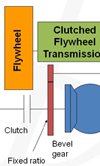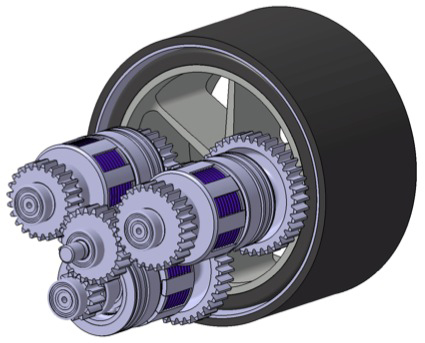Le Mans Prototype flywheel hybrid
 There have been a number of articles in the press on the benefits of a flywheel-based hybrid system for motor racing - indeed, Porsche has been racing a flywheel hybrid system in selected GT races. This is based on the same technology that Williams had begun to develop for its Formula One car for the 2009 season, but which didn't race. In this system, the flywheel and alternator are combined, so the system is a mix of the benefits of flywheel energy storage and the well-known technology of the electric motor.
There have been a number of articles in the press on the benefits of a flywheel-based hybrid system for motor racing - indeed, Porsche has been racing a flywheel hybrid system in selected GT races. This is based on the same technology that Williams had begun to develop for its Formula One car for the 2009 season, but which didn't race. In this system, the flywheel and alternator are combined, so the system is a mix of the benefits of flywheel energy storage and the well-known technology of the electric motor.
Flybrid Systems' approach is again based on a flywheel, but is a purely mechanical system. Again developed originally for Formula One, Flybrid's system wasn't raced in 2009. Besides the KERS regulations for Formula One, the ACO, which organises the Le Mans 24 Hour race, has supported hybrid technology for a number of years.
In 1998, Panoz entered a hybrid for the 24 Hour race, and in subsequent years there have been a number of ACO-sanctioned endurance races in which hybrid prototype cars have competed. Peugeot is known to be developing a hybrid system for its new diesel-powered car which will race under the new 2011 LM P1 rules, Porsche has the GT, and rumours abound that the new Aston Martin LM P1 will also use hybrid technology.
To this list, we must add the purely mechanical Flybrid system. In 2011, Flybrid will supply Hope PoleVision with its high-speed flywheel system, which will be installed on the bellhousing of the Lehmann-powered Oreca car's XTrac 1059 transmission. The Flybrid system is very compact, and is known to be a low-mass solution. According to Flybrid's Technical Director Doug Cross, the total mass penalty of having the system on the car is about 35 kg. Mass reduction has been an important part of the development of this latest Le Mans Prototype system.

The first Flybrid system was designed such that maximum power was available over the entire working range of the system. By comparison, an electric motor - which is essentially a constant-torque device - has a certain peak power speed, with power below this varying in proportion to motor speed. Cross says that, in attempting to supply full power over the entire range, the first system was heavier than was really required.
The application of the extra performance is controlled by computer rather than being in the hands of the driver, and the power of the system is allowed by regulation to be 100 kW in both energy release and capture modes. The energy storage is about 500 kJ. The location of the flywheel system on the bellhousing means the car be driven by the flywheel with the engine turned off, as required under the ACO rules.
The ACO rules also limit the use of the full hybrid functionality as might be available in a road application, and state that "a traction control system operating exclusively on the engine is authorised". In traction-limited situations, a hybrid can provide a degree of traction control.

The duty cycle and length of the Le Mans race is something that should not limit the performance of the Flybrid system in the same way that an electric hybrid might need to be de-rated. However, Cross says that, owing to the minimal cooling requirement for the system, the cooling would be sensitive to debris blocking the rows of the oil cooler dedicated to the cooling of the KERS system, and that "a mitigation strategy has been developed to cope with a blocked cooler".
This would reduce power a little until such time as the debris blocking the cooler could be removed. The fondness of some teams for overnight gravel-trap sojourns, and the amount of tyre debris on the track in the latter stages of the race, means that having this strategy is important.
The Lehmann engine is a 2 litre turbo The transient response of turbocharged engines is critical for race applications, and developing an anti-lag system is an important aspect of the performance of the car. In this respect a KERS system can augment the transient response, providing an instant response to changes in throttle pedal position.
Fig. 1 - This schematic shows the position of the Flybrid KERS system in the 2011 LM P1 Oreca to be campaigned by Hope PoleVision (Courtesy Flybrid Systems)
Fig. 2 - The LM P1 KERS system incorporates Flybrid's new clutched CVT transmission (Courtesy Flybrid Systems)
Written by Wayne Ward